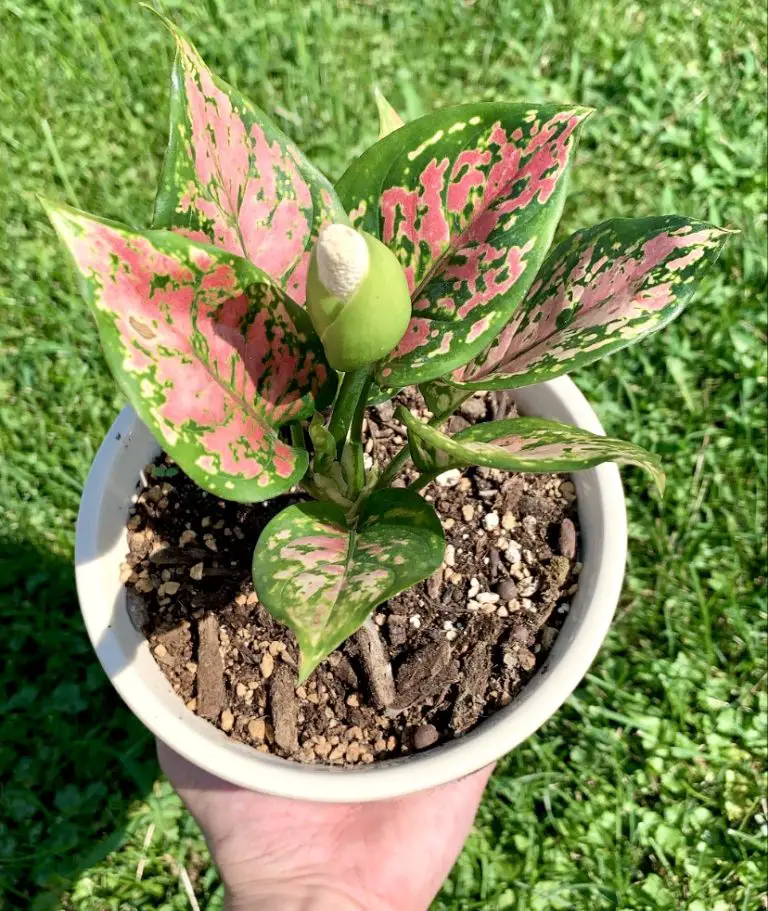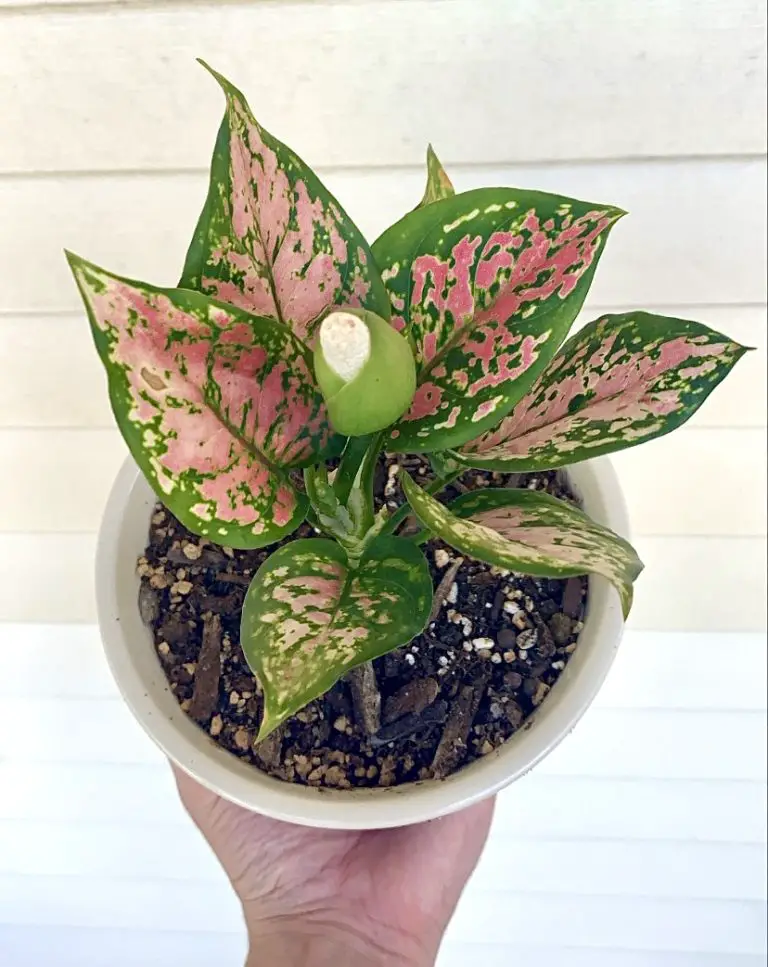Pink Aglaonema
Botanical Name: Aglaonema
Common Name: Pink Aglaonema, Chinese Evergreen, Pink Splash Aglaonema
Family: Araceae
About Pink Aglaonema
The Aglaonema (often referred to as Chinese Evergreen) is native to the rainforests of south-east Asia. Most prominently they can be found throughout Malaysia, the Philippines, and Thailand, where they can grow up to 4 feet tall. Indoors they can grow almost exactly as large. They are very popular houseplants due to their easy nature and the ability to survive in low light. Aglaonema also comes in many varieties from plain green foliage to dotted pink types making it easy to find one to your likings.
An interesting feature of this plant is its willingness to bloom indoors; you can see it’s inflorescence in the photograph above. As it is part of the Araceae family of plants it does not produce flowers but rather an inflorescence. An inflorescence is a single floral stalk that carries a cluster of flowers bunched together enclosed in a protective leaf. The flower cluster and its stalk are referred to as the spadix, the surrounding leaf that is there to protect the flower cluster is known as the spathe. The inflorescence of Aglaonema does not carry a strong floral scent but that doesn’t make them any less interesting.
Light
While Aglaonemas are known to be extremely versatile in terms of light needs, as a rule of thumb it is good to know that the more variegation and colors (other than green) mean the variety will require more/brighter light.
While Aglaonema with completely green foliage can thrive in low light, Pink Aglaonema and other variegated varieties will do much better in a spot with medium to bright indirect light. To keep the variegation bright and vibrant more light is always best. Aglaonemas generally do not appreciate any harsh or direct sunlight, it may cause sunburned foliage even with minimal exposure.

Water
The best practice when it comes to your (Pink) Aglaonema is to allow the top half of the soil to dry out completely between waterings. The stalks of the Aglaonema can store water for long periods so underwatering is rarely a problem. A moisture meter is a great tool to track when the soil is almost dry making it possible to always water at the perfect time. It’s also important to ensure you are placing your plant in a pot that has proper drainage to avoid root rot and other fungal problems that arise with sitting water.
Tip: if you place your Aglaonema in a spot with lower light it can (and should) go longer between waterings, if it is in a brightly lit spot check on your plant more frequently.
Humidity & Temperature
Aglaonema is a resilient variety of tropical plants, they can easily tolerate average indoor humidity levels. Anything above 40% relative humidity will be perfect for your Aglaonema. If you notice your plant is displaying brown leaf tips and crispy edges this may be a sign that higher humidity is needed. I always suggest grouping plants together or adding a pebble tray with water as a saucer under your plants’ pot to increase the relative humidity in its microclimate.
In terms of temperature (Pink) Aglaonema are warmth lovers. Coming from tropical rainforests they are used to temperatures not falling below 60 degrees very often. It is best to keep your Aglaonema in an environment where temperatures are consistently between 65 and 80 degrees Fahrenheit. Anything below 55 – 60 degrees Fahrenheit can cause your plant to drop leaves, go dormant, or even die off, so proceed with caution if you plan to keep your plant outdoors during part of the year.

Toxicity
Aglaonemas are moderately poisonous to both humans and cats and dogs if any part of the plants is consumed. If you have curious children or pets make sure to keep this plant safely out of reach.
If you notice your pet has consumed any part of an Aglaonema plant it is advisable to seek the help of a licensed veterinarian as soon as possible.
Tips
As the stalks of the Aglaonema plant store water for times of drought, it is best to allow your plants’ soil to dry out completely every once in a while to avoid any pesky problems with root rot or fungal bacteria spreading through the wet soil.
If you prefer a full and bushy plant over a tall (Pink) Aglaonema it is advisable to periodically remove new leaves as they appear. You can do this by grasping the new leaf by the stem and then firmly pulling to remove the entire stem, this will promote branching and a bushier appearance.
Frequently asked questions
Why are the leaves on my Aglaonema drooping?
Drooping leaves can be an indicator that either there are problems with lighting conditions or watering. If your plant has droopy, wilting leaves with a pale-ish yellow color this most likely points to not enough light, on the other hand, if the leaves are droopy and dry/crispy with brown spots this is caused by too much or too direct sun.
It is also important to check your soil when you notice drooping leaves, if your plant’s soil is moist and its leaves are brown and yellow the problem may be too much water; allow the plant to fully dry out and give it a bright spot to see if it can recover. If you have crispy leaves and dry soil try watering and see if your plant bounces back.
How often should I water my Aglaonema?
Short answer: it depends!
If you have your Aglaonema in a brightly lit spot it may require a weekly watering of its soil, whereas if your plant is in a dimly lit corner it may only need a smaller amount of water every two to three weeks. The best practice is to water your Aglaonema when its soil is almost completely dried out. I would highly recommend obtaining a moisture meter to check the moisture level of your plants’ soil, that way you never water at the wrong time.
Can you propagate Aglaonema?
Yes, it is certainly possible. The best way to go about propagating your Pink Aglaonema or any other variety is to take a stem cutting and allowing it to root in water before transplanting. I would recommend choosing a stalk of your plant that has at least three healthy leaves. Cut the stem right below a node and then place it in water in a brightly lit spot. Now you just have to wait until the root system is established enough to transplant the cutting into soil. This may take anywhere from a couple of weeks to a few months depending on the plants and the lighting conditions.